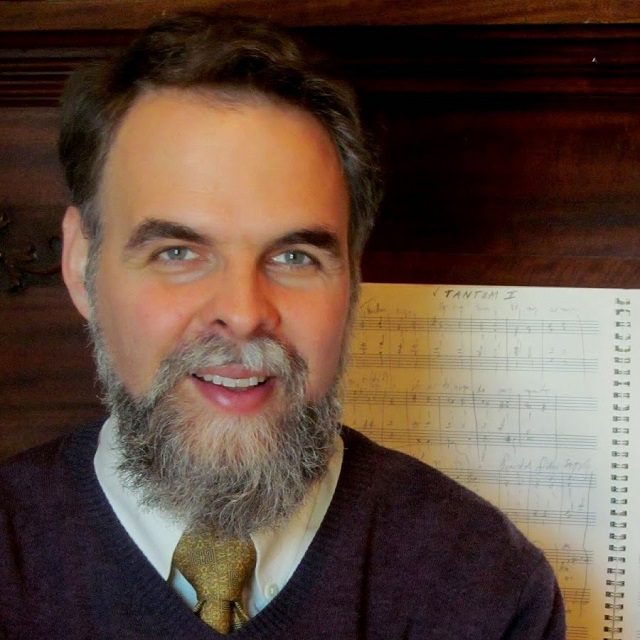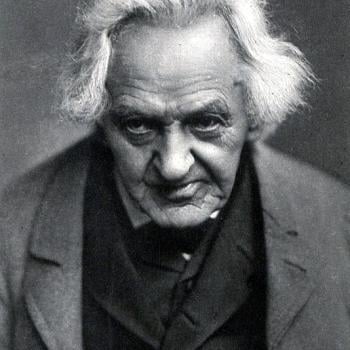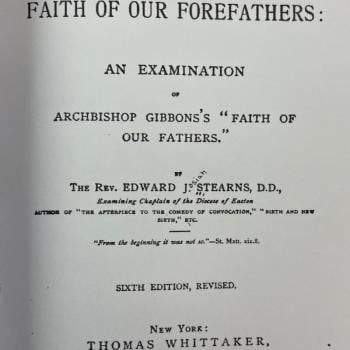vs. Dr. Peter Kwasniewski

Peter Kwasniewski [You Tube image / Creative Commons license]
***
This is from an exchange on my Facebook page with Dr. Peter Kwasniewski: Professor of Theology and Philosophy at Wyoming Catholic College, and contributor to the reactionary sites, One Vader Five and Rorate Caeli. He was responding to my post, Are Deaconesses Inconceivable? No. I engaged in very lengthy dialogue with him regarding the reform of the liturgy, in February 2014 (see Part I / Part II). His words will be in blue.
*****
You are a spirited one. But sometimes your zeal gets the better of your logic. It happens to all of us at times. I do admire zeal and passion. I just like it to be much more harmonized with reason, theology, and history.
Oh, sure, deaconesses in the ancient church meant just what people today want them to mean, right?
What they meant and what liberals today “want” them to mean are, of course, two entirely separate issues: both of which I dealt with. So it is beyond silly for you to make this remark, implying that I confused the two things. I did not at all.
There are legitimate doctrines and practices of the historic Catholic Church (we shall call them “x”) and there are various “pseudo-x’s” which liberals dream up in their seemingly fertile but oh-so-flawed brains.
I dealt with the biblical and patristic existence of deaconesses (i.e., x). Deal with it. Nothing that is in inspired Scripture and widely accepted in the early Church can be so casually dismissed as “liberalism”: as if there are no nuances or complexities or fine points here at all.
That’s the difference between my analysis and yours. I actually took the biblical and patristic data seriously (even using that notoriously liberal source: The Catholic Encyclopedia of 1913)!
You, on the other hand, use the current discussion, brought on by Pope Francis (just as traditionalists used Amoris Laetitia) as an opportunity to do the usual tired play book analysis of ambiguity, liberals-under-every-rock, hand-wringing cynicism.
And there wasn’t a good reason why deaconesses disappeared over time, as women’s religious orders developed, right?
There could be various good reasons, and I assume there were (that the Church in her wisdom applied). But since this is not (I don’t think) a matter of unchangeable dogma, it’s not unthinkable that it could be modified, precisely like priestly celibacy (which operates differently in the Eastern Church), and the reintroduced diaconate after Vatican II. Are you against (male) deacons as a supposed corruption, because it came back in the last 50 years? Does the Church need to be scolded and slapped on the wrist for that, too?
It’s the same scenario with something like Mass in the vernacular. It largely went away for centuries, and then it came back, and did so with the blessing of Holy Mother Church. Individual Bible reading is much more encouraged than it used to be, etc. Lay ministries (including apologetics) are relatively more encouraged.
And the women’s ordination movement has nothing to do with this, right?
As I made very clear: “Of course it is a ‘stalking horse,’ for liberals. I’m saying that their predictable seeking to co-opt something for modernist / heterodox ends is not in and of itself a reason to rule anything out, since every good thing is distorted, inside the Church and outside it.”
And it doesn’t fit into the pattern of destabilization, confusion, mixed messages, and panting after novelties, right?
That is your traditionalist spin. It is not at all necessarily the case that a re-examination of a quite arguably biblical and definitely historically widespread office that may again be useful in our time, is improper or “liberal” or anything of the sort. It fits into that pattern for those who want it to; who insist on squeezing the square peg into that round hole, so that it fits with a preconceived narrative of liberals supposedly wrecking everything whatsoever in the Church.
On your marks… get set… go apologists!
I done went. God is my witness that I try to do the best job I can in lessening confusion and alarm, and to present the facts in a long historical perspective rather than merely in the bubble of our own time, through an arbitrary and predetermined biased filter.
I don’t even have a definite opinion on this. I made clear in three different statements that I was merely giving my ““raw” / off-the-cuff responses” and that “I don’t think it’s absolutely inconceivable,” and that “My opinion isn’t fully formed, but I’m just saying it’s not inconceivable.”
Thus, technically, this analysis of mine isn’t apologetics at all, since I haven’t taken a stand and defended it. I’ve done a biblical and historical survey and allowed readers to more fully form their opinions in light of those things, and have argued against the thing being necessarily wrong or impermissible.
That distinction will be lost on many, because that’s just how it is; but I do what I do (giving it my best shot), and folks can either understand what I am arguing or not.
When you’re living in the era of mercy, you don’t bother with such details any more. Bah, legalistic details.
When you’re operating in dogmatic strictures of legalism, you don’t bother with trifling details such as mercy and pastoral understanding anymore. Bah, biblical / pastoral details . . .
When a practice existed and then disappeared, and for many centuries a different practice obtained — in the case of kneeling to receive communion on the tongue, a posture more expressive of reverence — then suddenly to change it “back” is to reject the symbolism that had been expressed for all those centuries. Everyone can see this and one only has to read what the progressives were saying back in the 60s and 70s to know that they knew it very well.
I’m reminded of people who try to defend modern art or rock music by saying “it’s not so bad after all, you can give it a good meaning.” But that’s not the meaning its originators and proponents gave it — and it’s not the common sense view, either. Apologetics should follow common sense or it risks looking absurd.
First of all, as I have stated and reiterated: I am not defending deaconesses. I don’t have an opinion on it. It is a matter of perfect indifference to me in my current state of knowledge regarding it (which isn’t all that great). All I argued was that it was “conceivable”, and I provided a history of the practice, in order to show that it is not automatically (and intrinsically) some “crazy / liberal” innovation.
Thus (as also pointed out), I am not doing apologetics here, by definition, since I’m not defending anything. I’m functioning more in this instance as an amateur historian / sociologist.
Secondly, I have had a lengthy debate (almost eight years ago now) on precisely the issue you raise: why change a practice after centuries of development of another practice?: Dialogue: Receiving Communion (vs. Traditionalist) [David Palm]: “Traditionalist” Argument from Liturgical Development: Method of Receiving Communion.
There cannot ever be a good argument for dismantling that which so richly and evidently expresses our adoration of Christ truly present in the blessed Sacrament. The change was evilly motivated and has had evil results. No anthropologist or sociologist would question for a moment that kneeling is a powerful religious gesture — indeed, this is why we do it during the consecration. To take this away at communion time was to inculcate a different theology.
1. It’s not “dismantled,” since every Catholic has the canonical right to receive kneeling and on the tongue, and the Church has encouraged wider use of the traditional Mass in both the extraordinary and ordinary forms.
2. I myself have attended a traditional Latin Mass (Novus Ordo) for 25 years. My parish offers the extraordinary form also, and I occasionally attend it, as I did last Christmas.
3. I always receive on the tongue, kneeling, in my own parish.
4. I defend kneeling as relatively more reverent in our culture.
5. But I refuse to get legalistic and condemn all reception in the hand, standing, as intrinsically inferior or inherently and necessarily irreverent, for two reasons:
a) Reverence (like its opposite, idolatry) is essentially and fundamentally a matter of the heart and interior disposition. It can be (outwardly) expressed with various postures besides kneeling.
b) Since receiving in the hand, standing, was the norm in the Church for its first 6-9 centuries we can hardly argue that the practice is intrinsically irreverent, nor can we say that this posture is “evilly motivated and has had evil results”. Nor can we say that it necessarily implies a “different theology.” Your reasoning in all this is (with all due respect) incredibly shoddy. You connect dots all over the place that have no logical connection to each other.
6. There are various other factors besides posture, for any irreverence that actually takes place. But it is standard reactionary (and sometimes traditionalist) reasoning to foolishly assert one uber-cause for any negative phenomenon (lack of belief / irreverence, etc.). Hence, Vatican II is regarded as the locus of evil (rather than the sexual revolution, secularism and other socio-cultural factors). Or the Novus Ordo Mass is blamed for all liturgical abuses. Currently, the pope is receiving the brunt of the accusations of a supposed deliberate modernist conspiracy led by him, for the purpose of perverting the Church and her traditions.
General question: Why this frenzied need to explain and defend every single idiotic idea that comes along, even when thorough work has already been done to discredit said idea? It’s a symptom of some kind of desperate need for an oracle and absolute monarch on whom one can hang for reassurance. The Catholic Faith has nothing to do with this weird superstition.
1. I have not “defended” it, myself, insofar as I am concerned.
2. Whether it is “idiotic” is a question to be determined. I would tend not to call “idiotic” a practice that already has an honored history of many centuries in the Church, or at least large portions of the Church (the Eastern sector in the early, undivided Church: i.e., pre-Orthodoxy).
3. No one (last of all, meself) has argued in terms of “an oracle and absolute monarch”. That is simply your straw man projection of an exaggerated, caricatured picture of how non-traditionalists view the pope. If anything is “idiotic” here, it is that. If you protest its idiocy, then kindly produce evidence of anything remotely approaching such “papolatry” among “defenders” of deaconesses, or even those (like myself) who simply say it is a possibility.
4. Having set up this straw man, you label it “superstition” and dismiss it as entirely unCatholic. But since it is a straw man fiction in the first place, the additional judgment upon it has nothing to do with anything, and is perfectly irrelevant.
My point about “idiotic” was mainly to say that there are things one does not revive because too much water has passed under the bridge and words do not simply retain their original meaning. No matter how much you explain it, “deaconess” will mean one thing and one thing only: a female ordained minister with a position in the clerical hierarchy. Over a thousand years ago maybe it meant something else, but who cares? Language and ideas are not frozen. This is the reason why it was so dumb for the liturgical reformers to think they could leap-frog over centuries of organic development to get back to a supposedly “pristine” apostolic liturgy. That’s impossible.
I appeal back to my reasoning in my dialogue with my traditionalist friend, David Palm. Since development is my favorite theological topic, I rather enjoyed that, although I think liturgical development is a very different category from doctrinal development.
*****
Meta Description: Dr. Kwasniewski doesn’t like the notion of reintroduced deaconesses at all. I think it is “not inconceivable.”
Meta Keywords: Church offices, clergy, deaconesses, deacons, female priests, holy orders, ordination, Phoebe, priestesses, priests, Peter Kwasniewski












